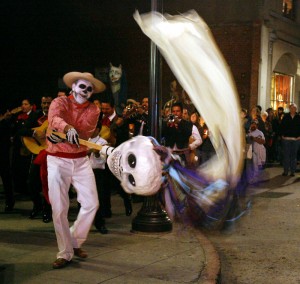
Abraham Solar dances with a giant puppet during a downtown procession in 2007. (Press Democrat file photo)
By SHELDON BERMONT / Petaluma Towns Correspondent
Nov. 2 is El Día de los Muertos, and for the first time in the celebration’s 11-year Petaluma history, 200 selected participants will be able to mark the occasion Tuesday night by paying their respects to loved ones in Cypress Hill Memorial Park.
The cemetery will host the proceedings, which will include placing flowers, sharing food and hearing the authentic and gentle sounds of music from the central-Pacific coast of Mexico.
Abraham Solar envisioned this important part of the month-long ceremony in 2000, when he helped to bring the holiday to Petaluma. He also knew that bringing two cultures together in an eclectic, month-long celebration would not be easy.
Solar and co-coordinator Gloria McAllister planned to first educate the Anglo community about the holiday and then gradually add the various traditions to the mix.
This year they were ready to bring it to the next level. Abraham made the request, and Jim Smith and Buzz Rodgers of Parent-Sorensen Mortuary gladly extended their hospitality to the “Day of the Dead” 200.
Día de los Muertos is a distinct departure from North American views about the passing of life. “This is a way for the community to honor the life and legacy of friends and family while moving forward with the celebration of life,” Abraham explains.
In 1910, a Mexican artist named José Guadalupe Posada created a series of politically-aware and satirical cartoons. His drawings of hat-wearing skeletal figures were meant to be a wake-up call to his country’s rich and entitled, letting them know that all their greed and money would never keep them from the great equalizer, eventual death.
The message was poignant, but fell on the deaf ears of the empowered. Pasada’s dancing, grinning skeletons gained popularity and became the modern-day symbol for Día de los Muertos, an international holiday that can trace its origins all the way back to Mayan cultures.
It is Solar’s and McAllister’s goal to extend this tradition beyond the Latin-American community’s invisible boundaries.
McCallister explains that their fondest hope is to bridge cultural gaps, by initiating cross-cultural friendships. Describing the philosophy behind the celebration, she goes on to say, “It’s meant to help people embrace death as just another part of the beauty in life’s eternal cycle.”
The Graves of Maria Garcia (McAllister’s mother) and Lauren Ojeda (a well-loved and devoted member of the Hispanic Cultural Center for Youth) will be two of many gravesites the procession will visit.
Until this year, organizing the grave visitation was beyond the scope of the volunteer-based group, Solar said. He and McAlister have been dedicated to removing some erroneous notions about the holiday’s purpose. Among them:
* It is strictly a Catholic celebration. (Not so; varied religions and nations have taken part in versions across the globe.)
* It is only for and about the Latin-American culture.
* It is just a Latin-American version of Halloween. (Both are wrong.)
Día de los Muertos events have been going on since Sept. 30 in Petaluma, with Mayor David Glass signing a proclamation that extends the celebration from one week to the full month of October.
Seventy-five homemade altars, designed and constructed to honor the memory of loved ones, are on display throughout the city, and the Petaluma Arts Center has hosted many of the celebration’s events.
Virginia May, director of the Center, smiles as she says, “I love the warm-hearted celebratory feeling that exists when the Latino and Anglo communities come together to celebrate the cycle of life.”
To participate in the candle-light procession to the Cypress Hill, runs 6:30-9 p.m. Tuesday, Nov. 1., you must be registered in advance. Call 762-5600 or visit the Petaluma Arts Center at 230 Lakeville St. to get on the list.
